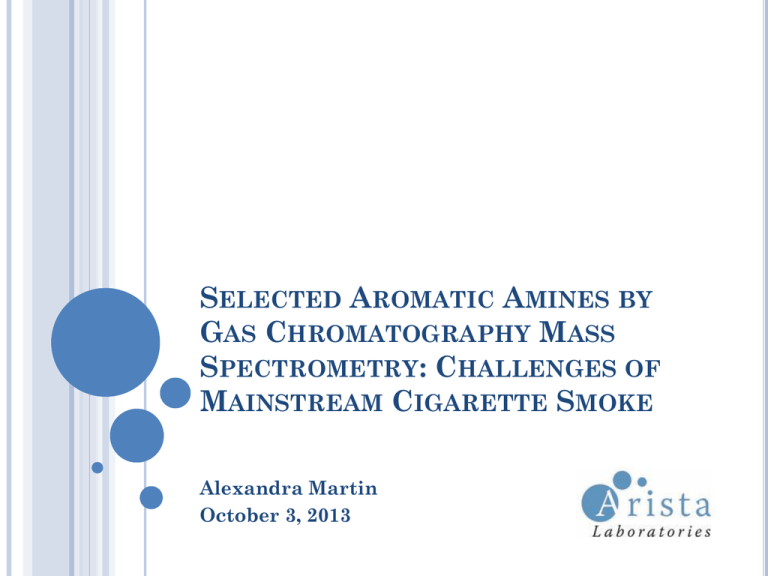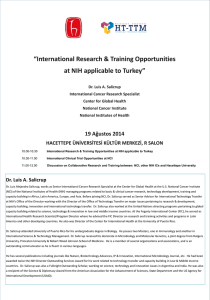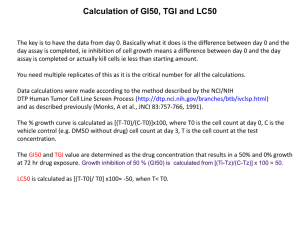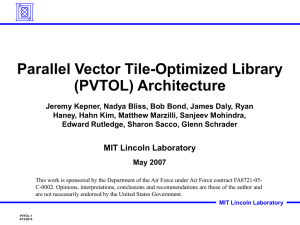
SELECTED AROMATIC AMINES BY
GAS CHROMATOGRAPHY MASS
SPECTROMETRY: CHALLENGES OF
MAINSTREAM CIGARETTE SMOKE
Alexandra Martin
October 3, 2013
OUTLINE
What are PAAs and why are they important?
Smoke Collection 101
Brief history of PAA analysis
New challenges - FDA HPHC list
SPE clean-up
GC-MS parameters – EI vs. NCI
Validation results
LOD/LOQ
Accuracy
Precision
WHAT ARE PAAS AND WHY ARE
THEY IMPORTANT?
BACKGROUND
Tobacco smoke contains more than 4,000
chemical compounds.
Characterization of this matrix has been the
focus of scientists for many years.
One of the goals of this work has been to identify
the compounds primarily responsible for serious
health effects.
IARC Monographs on the Evaluation of
Carcinogenic Risks to Humans - Classification
PAA CLASSIFICATIONS AND REPORTING
REQUIREMENTS
Compound
IARC
Class
Health
Canada
Brazil
ANVISA
ortho-toluidine
1
X
2,6-dimethylaniline
2B
X
ortho-anisidine
2B
X
1-aminonaphthalene
3
X
X
X
2-aminonaphthalene
1
X
X
X
3-aminobiphenyl
na
X
X
4-aminobiphenyl
1
X
X
US FDA
X
THE ORIGINAL FOUR PAAS
1-aminonaphthalene
2-aminonaphthalene
3-aminobiphenyl
4-aminobiphenyl
ADDITIONS FOR FDA HPHC LIST
o-toluidine
2,6-dimethylaniline
o-anisidine
SMOKE COLLECTION
CERULEAN 20-PORT SMOKING MACHINE
TOTAL PARTICULATE MATTER (TPM)
FROM 5 KY 3R4F CIGARETTES
BRIEF HISTORY OF PAA
ANALYSIS
AMERICAN HEALTH FOUNDATION
METHOD
“On the Analysis of Aromatic Amines in Tobacco
Smoke”. C. Patrianakos, K.D. Brunnemann and
D. Hoffmann, American Health Foundation,
Valhalla New York 10595.
Presented at the 31st TCRC, Greensboro, NC,
October 1977.
C. Patrianakos and D. Hoffmann, “Chemical Studies on Tobacco Smoke LXIV. On the Analysis
of Aromatic Amines in Cigarette Smoke”, J. Anal. Toxicol., 3, 150-154 (1979).
AHF METHOD (1977)
Smoke Collection - 210 cigs
Impingers w/ 5% HCl
[Add ISTDs]
Liquid:Liquid Extraction w/
Ether
Dry and Concentrate
Derivatize (PFPA)
AHF METHOD (1977) CONTINUED…
Wash, Dry, Evaporate
Florisil – 10 g
Fraction (75 mL), Evaporate
Florisil – 30 g
Fraction 1 (500 mL) and
Fraction 2 (400 mL)
Evaporate each to 2 mL
GC-MS or GC-ECD Analysis
HEALTH CANADA METHOD
Health Canada Official Test Method T-102, 1999
Based upon Pieraccini et al 1992
Modifications
CFP for trapping, not impinger
Smaller volume solvent used
Fewer evaporation steps
Much better LOQs
G.Pieraccini, F. Luceri and G. Moneti, “New Gas-chromatographic/Mass Spectrometric Method
for the Quantitative Analysis of Primary Aromatic Amines in Main- and Side-stream Cigarette
Smoke. I”, Rapid Communications in Mass Spectrometry, 6, 406-409 (1992).
HC T-102 METHOD (1999)
Smoke Collection - 10 cigs
Extraction of CFP w/ 5% HCl
[Add ISTDs]
Liquid:Liquid Extraction w/
Hexane
Derivatize (TMA / PFPA)
Florisil SPE (3 g)
GC-MS Analysis
NEW CHALLENGES: FDA HPHC
LIST
GOALS OF NEW METHOD
One method to determine all 7 PAAs.
No evaporation steps.
Evaluate SPE clean-up to reduce solvent use and
improve reproducibility and efficiency of method.
Retain the advantages of NCI (lower detection
limits, improved selectivity).
NEW SAMPLE PREPARATION SCHEME
(ARISTA METHOD)
Smoke Collection (CFP)
Extraction of CFP w/ 5% HCl
[Add ISTDs]
SPE Clean-Up and Solvent
Exchange (DCM)
Derivatize (PFPA)
GC-MS Analysis (NCI)
SPE ADVANTAGES
Selectivity
Can selectively retain/release compounds of interest.
Requires small volumes of solvent
New method uses 8-10 mL vs. 60-70 mL with liquid:liquid.
Efficiency
Can process many more samples in a batch with manifolds of
up to 24 ports.
Effectively isolates and concentrates
analytes of interest!
WHY IS CLEAN-UP IMPORTANT?
Response
Interferences can swamp the system and reduce sensitivity.
Sample Throughput
Dirty samples can destroy the chromatography and suppress
the detector response and can increase down time due to
system maintenance.
Quantitation
With GC/MS by NCI PAAs have simple spectra - quantitation
is based on one significant daughter ion.
Clean-up and separation are critical!
KY 3R4F EXTRACTS
(NO SPE CLEAN-UP)
KY 3R4F EXTRACTS
(CATION EXCHANGE ONLY)
KY 3R4F EXTRACTS
(CATION EXCHANGE PLUS SILICA)
WHICH WOULD YOU INJECT?
CHROMATOGRAMS OF 3R4F EXTRACTS
(ISO SMOKING REGIME)
Cation plus Si SPE
Cation SPE only
CHROMATOGRAMS OF 3R4F EXTRACTS
(ISO SMOKING REGIME)
Cation plus Si
SPE
Cation SPE only
CHROMATOGRAMS OF STANDARD SOLUTIONS
(WHY CLEAN SAMPLES ARE IMPORTANT!)
1
CHROMATOGRAMS OF STANDARD SOLUTIONS
(WHY CLEAN SAMPLES ARE IMPORTANT!)
1
2
CHROMATOGRAMS OF STANDARD SOLUTIONS
(WHY CLEAN SAMPLES ARE IMPORTANT!)
1
2
3
WHY DERIVATIZATION?
O
NH2
+
F3CF2C
O
O
CF2CF3
4-aminobiphenyl
O
O
CF2CF3
+
N
H
F3CF2C
OH
DETECTION - EI
Electron Ionization
M + e- → M+ + 2e-
M+ produces a characteristic fragmentation
pattern or a “mass spectrum” specific to each
compound.
DETECTION – NCI
Chemical Ionization (methane)
CH4 + e- → CH4+ + 2eThe electrons have much lower energies. Most
compounds cannot form stable negative ions but
react with the CH4+ (PCI).
If a compound can capture and hold an extra
electron and retain a negative charge, it can be
observed in NCI mode.
MF + e- → MF- → [M-H]- + HF
EI VS. NCI SPECTRA FOR O-TOLUIDINE
EI VS. NCI SPECTRA FOR 4AMINOBIPHENYL
CHROMATOGRAM OF LOW STANDARD
(EI VS. NCI)
EI
CHROMATOGRAM OF LOW STANDARD
(EI VS. NCI)
EI
NCI
CHROMATOGRAMS OF A CIGAR EXTRACT
(EI VS. NCI)
o-toluidine
EI
1-aminonaphthalene
2,6-DMA
2-aminonaphthalene
3aminobiphenyl 4-aminobiphenyl
oanisidine
o-toluidine
NCI
2,6-DMA
1-aminonaphthalene
oanisidine
2-aminonaphthalene
3aminobiphenyl
4-aminobiphenyl
METHOD VALIDATION
VALIDATION PARAMETERS
otoluidine
2,6DMA
oanisidine
3-Day Precision
(n=20)
3.7%
6.0%
5.2%
Accuracy (n=49)
99.6%
95.4%
95.1%
LOD (ng/mL)
0.06
0.02
0.005
LOQ (ng/mL)
0.20
0.06
0.018
2.7 - 277
0.17 - 17
0.16 - 16
Linearity (ng/mL)
VALIDATION PARAMETERS
1-amn
2-amn
3-amb
4-amb
3-Day Precision
(n=20)
4.3%
5.2%
5.5%
5.0%
Accuracy (n=49)
95.8%
100.8%
94.3%
91.5%
LOD (ng/mL)
0.03
0.01
0.005
0.003
LOQ (ng/mL)
0.09
0.04
0.015
0.010
Linearity (ng/mL) 0.65 - 65
0.34 - 34
0.16 - 16 0.093 - 9.3
METHOD COMPARISON
(WE’VE COME A LONG WAY, BABY)
AHF
(1977)
HC T102
(1999)
Arista
(2012)
No. of Cigarettes
210
10
5
Volume Organic Solvent
(mL)
> 3000
~ 300
6–8
No. of SPE Steps
2
1
2
No. of Evaporation Steps
4
2
None
Final Volume (mL)
2
1
5
~ 4-AMB LOQ (ng/mL)
50
0.5
0.01
LCMSMS
J. Schubert, O. Kappenstein, A. Luch and T. G. Schulz, “Analysis of primary aromatic
amines in mainstream waterpipe smoke using liquid chromatography-electrospray
ionization tandem mass spectrometry”, J. Chrom. A, 1218, 5628-5637 (2011).
SUMMARY
Achieving lower and lower detection limits in
complicated matrix requires both improving
clean-up (SPE) and selectivity of the instrument
(NCI).
The method presented here demonstrates
excellent detection limits, selectivity, accuracy
and precision.
It is robust, efficient and fit-for-purpose,
accommodating the regulatory requirements of
Health Canada, ANVISA and the US FDA.
THANK YOU!









